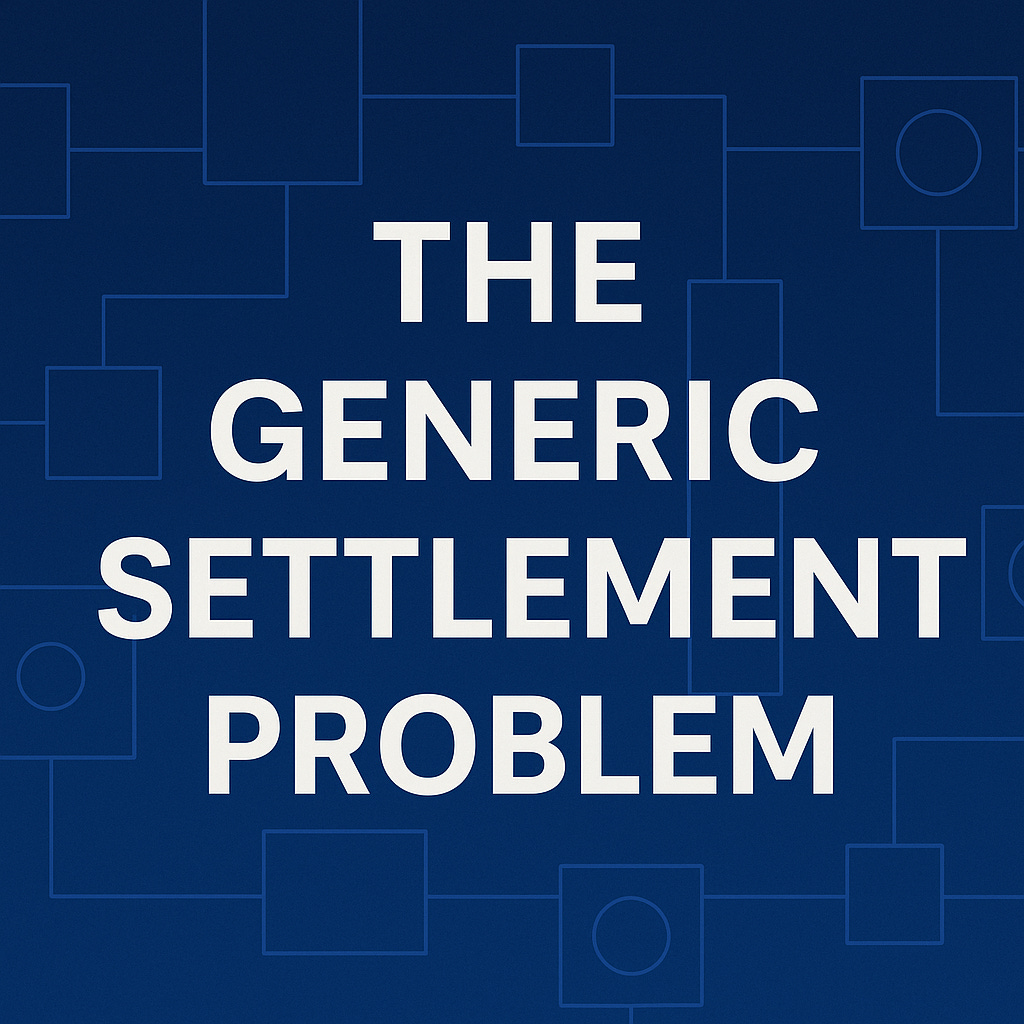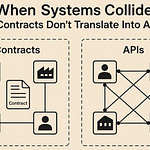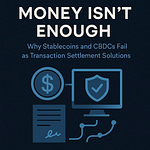Chapter 1: The Illusion of Specialization
For decades, we’ve built financial infrastructure like a patchwork quilt - each square tailored for one specific use case, one asset class, or one geographic region. There’s a system for cross-border payments. Another for securities. Another for trade finance. Each designed in isolation. Each with its own rules, its own APIs, its own reconciliations.
And yet, if you strip away the asset type, the institution, and the branding, they all perform the same essential function:
They finalize contracts.
Whether it’s SWIFT wiring funds, DTCC settling trades, or a fintech clearing stablecoins, they’re all asking the same questions:
Has Party A fulfilled its obligation?
Is Party B ready to fulfill theirs?
Can this be marked as complete - verifiably, irrevocably, and finally?
What we’ve called “settlement” is just the last phase of an agreement: the point where promises become outcomes. But because we never had a general-purpose protocol for expressing and finalizing those agreements digitally, we resorted to building specialized machinery for each type of promise.
This is why:
Securities require a central depository.
FX trades rely on a synchronized CLS settlement window.
Stablecoin redemptions require platform-specific rails and rules.
Government payments move through bespoke inter-agency gateways.
None of these systems exist because the problem is inherently different. They exist because the digital tools to solve the problem generically didn’t exist. Until now. What’s emerging is a radically simpler way forward:
A model where digital contracts between verified agents can encode any obligation, manage its conditions, and verifiably finalize its settlement - without needing a separate infrastructure for each case.
This shift reveals a hard truth:
Most of our current settlement systems are just workarounds for the lack of a proper contract finalization architecture.
And that’s the real problem we need to solve - the generic settlement problem.
Chapter 2: What Is Settlement, Really?
Settlement is often described with jargon: “T+2,” “finality,” “clearing,” “netting,” “gross,” “real-time,” and “atomic.” But none of that is the essence.
Strip it to fundamentals, and settlement is simple:
Settlement is the verifiable discharge of obligations between known parties.
It’s not about the system doing it. It’s not about the asset being settled. It’s about the contract being closed. You do what you promised. I do what I promised. Everyone agrees it’s done. Irrevocably. That’s settlement.
It doesn’t matter if the obligation is cash, shares, freight, a tax payment, or a carbon offset. The core pattern is the same:
There’s a promise - made by one or more parties.
There are conditions - which must be met for the promise to be fulfilled.
There are actors - responsible for fulfilling those promises.
There’s execution - an act that fulfills the obligation.
There’s proof - that the execution happened as promised.
There’s finality - a mutual recognition that the contract is closed.
That’s it. That’s settlement in every domain.
Whether you’re moving billions in sovereign bonds or paying a parking ticket, the underlying structure doesn’t change. But because we never built infrastructure that could model this general pattern, we created narrow solutions for each domain instead.
We called them payment systems, clearinghouses, CSDs, bridge protocols, e-invoicing platforms, tax remittance networks - but under the hood, they were all solving the same thing in slightly different ways.
They weren’t solving different problems. They were building around the same missing layer.
And here’s the deeper truth:
Settlement is not a financial services problem. It’s an infrastructure gap.
Once we can model, verify, and finalize contracts between known digital agents - across organizations and jurisdictions - we no longer need an army of bespoke settlement systems. We just need agents, obligations, and protocols for finalizing them. The rest is ceremony.
Chapter 3: The Legacy Approach - Siloed by Asset
If the logic of settlement is so simple and universal, why did we end up with a dozen different systems - each built around one asset class, one geography, or one industry vertical?
Because in the absence of a general solution, we built specific workarounds.
Each workaround became an institution. Each institution built an API. And over time, the workaround became so embedded that we forgot it was a workaround.
Payments? One rail per country.
In the U.S., you wire money through ACH or Fedwire.
In Europe, SEPA handles cross-border euro payments.
In the UK, it’s BACS or Faster Payments.
Card networks like Visa and Mastercard have their own private settlement processes.
SWIFT exists not to move money, but to coordinate the messaging between banks that do.
Each one with its own standards, cut-off times, reconciliation flows, and compliance hooks - all to move value from A to B under predefined obligations. All to close a contract.
Securities? Centralized by design.
Capital markets rely on CSDs - Central Securities Depositories - to manage asset ownership and delivery.
DTCC in the U.S.
Euroclear and Clearstream in Europe.
CREST in the UK.
CHESS in Australia.
Their job is to ensure that when you buy or sell an asset, delivery and payment happen safely and correctly. But it’s the same structure: one party commits to pay, the other commits to deliver, and both sides need assurance that the exchange will settle.
We built huge organizations and regulatory frameworks to guarantee something that is, at its heart, a contract finalization event between two parties.
Trade, supply chains, and financing? A maze of portals.
Trade finance requires letters of credit, bank guarantees, bills of lading, shipment tracking, customs documentation.
Each of these is a promise tied to another promise, coordinated through an opaque choreography of PDFs, emails, and manual approvals.
Settlement here means goods were shipped, funds released, collateral cleared, insurance paid out.
Yet again, it’s all about verifying conditions, executing actions, and recognizing fulfillment. The fact that it spans five institutions and twelve PDFs doesn’t make it a different problem - just a poorly solved one.
Crypto? Same fragmentation, new language.
The promise was simplification. The reality: even more silos.
Stablecoin platforms have custom redemption networks.
Wrapped tokens rely on bridges and custodians.
Every chain has its own wallet format and token standards.
Inter-chain settlements involve relays, multisigs, oracles, and timeout conditions.
Instead of building a generic model for verifiable obligations and their finalization, crypto copied the old world - only faster, more public, and with new failure modes.
Each system we built was justified by the asset it handled. But all were really trying to answer the same question: Has the obligation been met?
And we kept solving it with bespoke, asset-specific plumbing because we never stepped back to design a shared contract layer - one that works for any obligation, any asset, any interaction.
What we needed was a generic protocol for verifiable settlement. What we got was a mess of incompatible systems trying to fake it.
The result? Redundancy. Friction. Cost. Risk. Delay.
And a massive opportunity to do it differently.
Chapter 4: Why “Stability” Is Over-Emphasized
Much of the recent innovation in settlement has fixated on a single idea: stability. Stablecoins. CBDCs. Fiat tokens. Bank-issued digital money. All positioned as the missing piece for safe, real-time settlement in the digital world.
But there’s a misunderstanding at the heart of this movement:
Settlement does not require stability of value. It requires stability of execution.
The obsession with creating price-stable digital tokens has distracted us from the real problem: the lack of reliable, verifiable, contractual fulfillment.
What Stablecoins Actually Solve
Stablecoins were invented to bridge volatility - to offer a dollar-like asset in crypto environments where native tokens fluctuate wildly. They work because they abstract away price risk. But they don’t solve settlement:
A stablecoin doesn’t know if it was paid in the right amount or to the right party.
It doesn’t confirm that delivery occurred.
It doesn’t enforce conditions.
It doesn’t provide finality - unless wrapped in a separate platform or protocol.
Stablecoins are static bearer instruments. They represent value, but they don’t manage the obligations behind it. Which means they still require a surrounding infrastructure - custodians, auditors, redemption mechanisms - to be usable for real-world settlement.
And all of that infrastructure? Just a poor substitute for a proper contract.
Settlement Is About Performance, Not Pegs
Real settlement systems - whether legal, financial, or technical - don’t depend on price stability. They depend on predictability, enforceability, and verifiability. That’s why most real-world settlement today still uses contracts, not tokens.
In trade finance, banks issue guarantees - not coins - to assure payment.
In insurance, underwriters agree to payout clauses, not on-chain reserves.
In FX, forward contracts lock in rates for future settlement - they don’t need stablecoins in every currency pair.
And yet, in digital finance, we keep chasing stability as if it’s a prerequisite for trust. It’s not. What’s missing is programmable performance guarantees.
A Better Way: Contractual Stability
In a contract-based system like ITL, you don’t need a stable asset to achieve a stable outcome. You just need:
A clear definition of who owes what
Verifiable credentials defining obligations
Conditions under which the obligation must be fulfilled
A contract agent to finalize once all conditions are satisfied
If price fluctuation matters, it can be encoded into the contract:
FX rate locks
Performance bonds
Dynamic pricing
Escrow with dispute resolution
Or - if certainty is needed - the contract can include a guaranteer agent. Someone who absorbs risk and ensures execution.
That’s real stability. Not a coin with a 1:1 peg, but a system of verifiable, enforceable commitments.
Stop Building Around the Peg
Trying to make every asset “stable” is like trying to redesign money to replace contracts. It’s backwards. In reality:
Price is negotiable.
Value is contextual.
What matters is that all parties agree on the outcome - and that outcome is fulfilled as promised.
That’s what settlement needs to deliver. Not price stability - but contractual integrity.
Chapter 5: The ITL Paradigm - One Network to Settle Them All
What if settlement wasn’t something special? What if it wasn’t a separate industry, platform, or process?
What if settlement was just the final step in every digital contract - native, verifiable, and automatic - not because someone operated a settlement system, but because the system itself was a contract?
That’s the Internet Trust Layer (ITL) paradigm. At its core, ITL makes one radical assertion:
Every economic interaction is a contract. Every settlement is just a contract finalization.
And once you accept that, the fragmentation of today’s financial infrastructure becomes unnecessary.
The Building Blocks of the ITL Model
1. Agents with verifiable identity
Every participant is represented by a cryptographically rooted digital agent - bound to a real person or institution and identified by a decentralized identifier (DID). There’s no ambiguity. No anonymity unless deliberately permitted.
2. Multi-party contracts as protocols
A contract isn’t a file. It’s a structured interaction protocol between agents. Each agent agrees to perform specific actions under specified conditions. These commitments are signed, traceable, and stored in the agent’s own ledger.
3. Verifiable credentials as obligations
Money, goods, services, rights, approvals - they’re all modeled as credentials. A stablecoin? Just a digital claim signed by an issuer. An invoice? A credential from a seller to a buyer. A tax rebate? A credential from a government to a citizen.
4. Contract agents for execution and finalization
Once all preconditions are satisfied - proofs submitted, payments confirmed, deliveries logged - the contract agent finalizes the interaction. It issues outcome credentials to all parties, closing the loop.
No clearinghouse. No back-office reconciliation. Just instant, cryptographic finality.
One Model, Many Use Cases
The ITL model doesn’t care what the contract is about.
A payment is just a promise to transfer value.
A securities settlement is two promises with delivery conditions.
An insurance payout is a conditional release based on oracle data.
A cross-border remittance is a contract between two banks and a user agent.
A stablecoin redemption is a call on an issuer’s liability.
The difference isn’t technical. It’s contextual. The same underlying protocol handles all of them. That means:
No need for separate APIs per asset type
No asset-specific platforms or permissioned blockchains
No wrap/unwrap/bridge logic for tokens
No reliance on a central party to confirm who did what
The only infrastructure you need is the contract itself - and agents that trust each other enough to engage with it.
Interoperability Without Integration
The magic of ITL is that it enables global, cross-institutional interoperability without requiring systems to be tightly integrated. Each agent:
Maintains its own ledger
Signs its own claims
Participates only in the contracts it agrees to
Finalizes only what it is part of
Yet everything remains verifiable to third parties - because the logic, participants, and credentials are transparent and signed.
Settlement becomes not just generic, but composable.
You can layer:
Guarantees over payments
Insurance over shipments
Financing over invoices
Compliance rules over identity proofs
All through a modular stack of contracts and agents.
Goodbye Infrastructure. Hello Protocol.
What today requires separate infrastructure - SWIFT, CSDs, clearinghouses, bridge protocols - can now be modeled as a contractual protocol executed by digital agents. No intermediaries. No intermediated trust. Just:
Signed identities
Explicit obligations
Cryptographic execution
Decentralized finality
Settlement isn’t something you bolt on. It’s something you design in.
And once you do that, the concept of asset-specific settlement networks becomes not just inefficient - but obsolete.
Chapter 6: What Becomes Obsolete
The moment you shift from asset-specific settlement infrastructure to a universal, contract-based protocol, something remarkable happens:
Entire categories of financial infrastructure become unnecessary.
Not because the problems they solve go away - but because they are solved more simply, more generically, and more securely by the ITL model. Here’s what could get replaced - not hypothetically, but by design.
Payments Infrastructure
Obsolete:
National clearing systems (ACH, SEPA, CHAPS, Fedwire)
Payment intermediaries (SWIFT for remittances, correspondent banks)
Stablecoin platforms with dedicated redemption logic
Fintech payout layers (Wise, PayPal, Revolut)
Why:
Every payment is just a transfer obligation inside a contract. The contract defines when and how it finalizes. Value is represented as verifiable credentials. No need for interbank message relays or batch-based netting.
Securities Infrastructure
Obsolete:
Central Securities Depositories (DTCC, Euroclear, Clearstream)
Custodian-based clearing and settlement
Siloed post-trade workflows (confirmation, clearing, reconciliation)
Tokenized asset platforms with special-purpose DvP logic
Why:
Securities are just rights tied to digital identities. Transfers are bilateral or multilateral contracts. Delivery versus payment becomes a standard two-sided contract with synchronized finalization. No need for massive infrastructure layers to orchestrate trust.
Trade & Supply Chain Settlement
Obsolete:
Letter of credit platforms
Bank guarantee clearing services
E-invoicing hubs and portals
Trade finance consortia with closed APIs
Why:
Invoices, deliveries, inspections, and financing can all be encoded into a single multi-party contract. Each party issues or accepts verifiable credentials. Finalization triggers payment or release automatically. No manual coordination or document tracking systems needed.
Cross-Border Systems
Obsolete:
FX settlement networks (CLS, bilateral nostro/vostro systems)
International tax and compliance pipelines
Currency-specific stablecoin rails
Why:
Contracts can include FX rate locks, taxes, and regulatory declarations. Multicurrency obligations are resolved at finalization with agreed exchange rates and trusted agents. No need to maintain liquidity pools or bridge protocols between siloed systems.
Reconciliation, Reporting, and Auditing Tools
Obsolete:
Back-office reconciliation systems
Regulatory reporting adapters
Manual audit trails
Why:
Each agent has a verifiable micro-ledger - a signed execution log of every contract they participated in. This makes reconciliation instant and auditing transparent. Nothing to reconcile. Nothing to dispute.
What Dies With Them
Reconciliation teams
Compliance delay
Friction from incompatible APIs
Counterparty risk from manual handoffs
Settlement delays (T+2, T+3, weekends, cut-off times)
Infrastructure redundancy
All of that disappears once contracts themselves become the infrastructure.
When you replace trust-by-infrastructure with trust-by-protocol, most of the infrastructure becomes dead weight.
What remains are just agents, contracts, and credentials - and that’s all you ever needed.
Chapter 7: From Special-Purpose Pipes to a Universal Protocol
Settlement was never supposed to be a product. It was never meant to be a platform, or a service, or a business model. It was the final step in a promise - the moment when “we agree” becomes “it’s done.”
But in the absence of a general digital mechanism to formalize and finalize that moment, we built special-purpose pipes: platforms, rails, APIs, institutions, intermediaries. Each one narrowly scoped. Each one asset-specific. Each one trying to answer the same question in a different language.
“Has this obligation been fulfilled - and can we all trust that it has?”
Today, we have the means to answer that question directly. Not by passing messages. Not by reconciling ledgers. Not by wrapping tokens or centralizing trust. But by using cryptographic agents that represent real-world participants and execute real-world contracts.
This is what the Internet Trust Layer provides. Not a service. Not a chain. Not a token.
A multi-party contract protocol - for expressing, verifying, and finalizing any obligation between any parties, anywhere.
What Changes
From:
Institutions reconciling batch files
Systems coordinating via message brokers
Custodians holding assets to simulate trust
Clearinghouses mediating risk
Repeated reinvention of the same logic in different silos
To:
Agents representing known parties
Contracts expressing obligations
Credentials proving actions
Finalization protocols closing loops
Verifiable logs eliminating disputes
This is not just a technical upgrade. It’s a shift from institutional trust to protocol trust.
One Layer to Settle Them All
The generic settlement problem doesn’t need another workaround. It needs to disappear. And it will - not through more infrastructure, but through much less.
A single protocol. A network of agents. A shared foundation of verifiable trust.
That’s how we move from 50 years of fragmented fixes to a future where everything settles the same way: Verifiably. Irrevocably. Automatically.
No rails. No bridges. No silos. Just contracts.
We don’t need better settlement systems. We need no settlement systems - because settlement should be a property of the contract itself.
This is what crypto promised, but never delivered for the real world.











